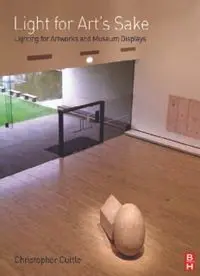
Light for Art's Sake: Lighting for Artworks and Museum Displays PDF
Preview Light for Art's Sake: Lighting for Artworks and Museum Displays
Light for Art’s Sake This book is dedicated to my wonderful family: Liz, Ken, Maureen, Rob, Maria, Kurtis, Hannah, and Jessica. Light for Art’s Sake Lighting for Artworks and Museum Displays Christopher Cuttle AMSTERDAM • BOSTON • HEIDELBERG • LONDON • NEW YORK • OXFORD • PARIS SAN DIEGO • SAN FRANCISCO • SINGAPORE • SYDNEY • TOKYO Butterworth-Heinemann is an imprint of Elsevier Butterworth-Heinemann is an imprint of Elsevier Linacre House, Jordan Hill, Oxford OX2 8DP, UK 30 Corporate Drive, Suite 400, Burlington, MA 01803, USA First edition 2007 Copyright © 2007, Christopher Cuttle. Published by Elsevier Ltd. All rights reserved The right of Christopher Cuttle to be identified as the author of this work has been asserted in accordance with the Copyright, Designs and Patents Act 1988 No part of this publication may be reproduced, stored in a retrieval system or transmitted in any form or by any means electronic, mechanical, photocopying, recording or otherwise without the prior written permission of the publisher Permissions may be sought directly from Elsevier’s Science & Technology Rights Department in Oxford, UK: phone (⫹44) (0) 1865 843830; fax (⫹44) (0) 1865 853333; email: ‘Art for art’s sake, with no purpose, for any purpose perverts art. But art achieves a purpose which is not its own.’ Benjamin Constant, 1767–1834, diary, 11 February 1804 ‘The painting must reveal itself in different aspects if the moods of light are included in its viewing, in its seeing.’ Louis Isadore Kahn, 1901–1974, Light is the Theme. This page intentionally left blank Contents Preface ix Acknowledgments xi Introduction xiii 1 A philosophy for the presentation of art 3 2 Revealing visual attributes 13 Light and illumination 13 Human response to light 17 Light levels in museums 28 Revealing with light 30 3 Light-induced damage to objects 39 Photochemical reactions 39 Radiant heating effect 40 Material response to exposure 41 Limiting exposure 45 4 Daylighting typologies 51 The aesthetics of daylight 51 Side-lit rooms 54 Monitor skylights 63 Central skylight picture galleries 67 Overall daylight-diffusing ceilings 79 Restricted daylight-diffusing ceilings 88 Polar-oriented skylights 92 Wall-lighting picture galleries 99 The presence of daylight 112 5 Daylighting controls 129 Light transmission 129 Light distribution 132 Ultraviolet transmission 137 Solar heat gain 138 Thermal transmission 140 viii Contents 6 Electric lighting typologies 143 The aesthetics of electric lighting 143 Room surface lighting 144 Lighting three-dimensional objects 152 Lighting two-dimensional objects 164 Case lighting 172 Supplementing daylight 183 Self-luminous art objects 186 7 Electric lighting controls 191 Light output control 191 Luminaire optical control 194 Luminaire directional control 209 Lighting control systems 209 8 Lighting strategies 213 Ambient illumination 213 A sequence of visual experiences 219 Minimal-exposure displays 236 The great space 245 Visual connections 254 9 Procedures for practice 263 A museum lighting pro forma 263 Setting up lighting for a new exhibition 275 Maintaining lighting during the life of an exhibition 279 References 281 Bibliography 283 Index 285 Preface People visit museums to experience objects rather than images, and among museums, the art museum provides for a special type of visual experience. Visitors want not only to see the object, but to gain an understanding of its nature and the artist’s intention in creating it. The underlying concept of this book is that lighting does not merely make things visible, but that it influences the appearance of everything we see. The nature of the lighting is inseparable from the visual experience of art. I have spent an entire working life in lighting, held by fascination for the manifold ways in which light’s interactions with matter inform and guide our lives. I have had opportunities to visit art museums in Europe, North America, Asia, and Australasia, and these experiences have provided a rich foundation for my teaching as well as the basis for this text. This book contains more than 200 of my own photographs gathered in these travels, and I should add a few words of explanation. Readers who are accustomed to see- ing the work of professional architectural photographers may be surprised by the casual, almost snapshot, appearance of some of these photographs. The point is that many of them have been taken when I was simply a ticket-holding visitor to the museum, and what I am showing is what a visitor sees. These photographs do not aim to show the art or the architecture, but rather selected aspects of the many different ways in which lighting influences the visual experience of art. Some truly interesting examples that I have seen are omitted because the institution concerned chooses not to allow visitors to take photographs. Occasionally I have requested photographs from such institutions, but they are seldom satisfactory. The precise alignment of the architectural geometry that they portray, and the total lack of human beings or even signs of their contact, creates, to my mind, an artificial appearance. However, the really damning factor is that almost invariably these photographers seem to be unable to resist the temptation of adding photoflood lighting, and of course, that completely defeats my purpose. So I ask readers to be tolerant of my hand-held photographs, and to appreciate that what I am showing is what visitors see.
